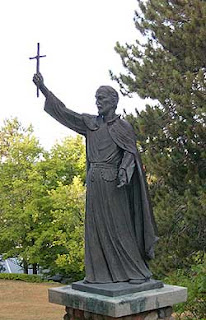
Pascal Tosi was born on April 25, 1837 in Santarcangelo di Romagna, Italy. He was one of the first two Jesuits missionaries to set foot in Alaska. As the first Superior of Jesuits in Alaska (from 1886 to 1897) he is regarded as the founder and organizer of the Church in North-Alaska.
Ordained a (diocesan) priest in 1861, Tosi entered the Jesuits the following year in order to be sent to the ‘American mission’. In 1865 he arrived in the United States to serve on the Rocky Mountain Mission. For two decades he proved to be an able missionary to the Indigenous Peoples of the American Northwest.
When in 1886 Archbishop Charles John Seghers set out for northern Alaska on what was meant to be a reconnaissance expedition, he had with him as travelling companions Pascal Tosi and French Jesuit, Louis Robaut. The two were supposed to stay with the archbishop only on a temporary basis. The Jesuits had no intentions at the time of opening a new field of missionary activity in Alaska. However, the murder of Archbishop Seghers (November 1886) changed the situation, and their thinking on the matter. (see my earlier blog on Bishop Seghers)
Tosi and Robaut spent the winter of 1886-87 in Canada at the confluence of the Yukon and Stewart Rivers. When in early 1887, upon entering Alaska, they learned of the death of Archbishop Seghers, Tosi considered himself to be in charge, at least for the time being, of ecclesiastical affairs in Alaska. The following summer he made a trip to the Pacific Northwest to consult with the Superior of the Rocky Mountain Mission, Joseph M. Cataldo, who formally appointed him Superior of the Alaska Mission and entrusted him with the task of developing that mission.
In 1892, he made a trip to Rome. There Pope Leo XIII, moved by Fr. Tosi’s account of the state of the mission in Alaska, told him in their native Italian, Andate, fate voi da papa in quelle regione! (“Go and make yourself the Pope in those regions!”).
On July 27, 1894, the Holy See separated Alaska from the Diocese of Vancouver Island and made it a Prefecture Apostolic with Tosi as its Apostolic Prefect.
By 1897, Tosi was physically worn out by a tough daily life and strenuous labors in an extreme climate. He was succeeded both as Superior of the Alaska Mission and as Prefect Apostolic in March of that year by French Jesuit Jean-Baptiste René (1841-1916). From St. Michael, on September 13, 1897, Tosi sailed, reluctantly, for he hoped to stay on in northern Alaska, for what turned out to be a brief retirement in Juneau. As the ship left the harbor, a salute of four guns was ordered as a manifestation of the universal esteem in which he was held.
Tosi died in Juneau on this day, January 14, 1898 and is buried in the Evergreen Cemetery under the false name of Father Tozier.
Wikipedia; LLORENTE, S. Jesuits in Alaska, Portland, 1969;TESTORE, C.Nella terra del sole a mezzanotte. La fondazione delle missione di Alaska. P. Pasquale Tosi S.J., Venice, 1935; ZAVATTI, S., Missionario ed esploratore nell’Alaska: Padre Pasquale Tosi, S.I., Milan, 1950.; Newadvent.com







